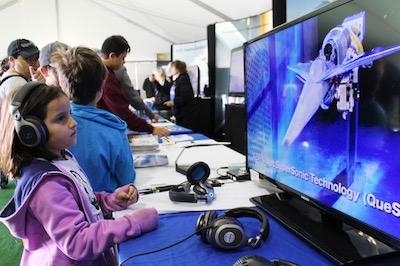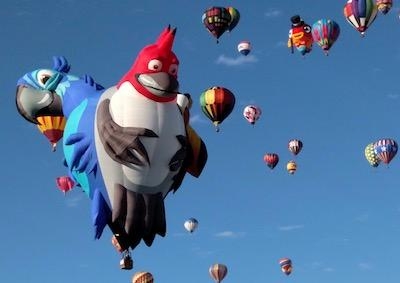Will Have An X-59 Balloon Flying At The Annual Event
As spectacularly colorful hot air balloons ascend to the skies, a different kind of inflatable will greet visitors to the NASA exhibit at the 48th annual Albuquerque International Balloon Fiesta in New Mexico Oct. 5-13.

NASA will have a large inflatable of one of its latest experimental aircraft, the X-59 Quiet Supersonic Technology, or QueSST. The X-59 is intended to demonstrate that supersonic aircraft can fly over land without disturbing communities, which could lead to reconsidering the restriction of over land supersonic travel and dramatically reduced flight times.
An inflatable of NASA’s signature logo will also help people know when they have arrived at the agency’s exhibit, which showcases some of the latest aeronautics innovations.
“This is a really exciting time for NASA’s work to improve flight,” said Karen Rugg, NASA Aeronautics’ lead for communications and STEM engagement. “Visitors to this year’s Fiesta will see the latest news about the X-59 Quiet SuperSonic Technology aircraft and our X-57 all-electric propulsion aircraft. And about how NASA-developed technologies are always with you when you fly – reducing noise, emissions and fuel use.”
A motor and propeller from a 31-foot-span, carbon-composite wing section called the Hybrid-Electric Integrated Systems Testbed will be on display. That research project was a step toward the distributed electric propulsion system developed for the X-57, NASA’s first human-piloted experimental aircraft in decades.
Under NASA's Transformative Aeronautics Concepts Program, the wing of an Italian-built Tecnam P2006T features an electric propulsion system. In a later phase, a special high aspect ratio wing with a distributed propulsion system will be used. Flight tests will allow a comparison of the performance of the X-plane with the original aircraft. The project, which involves multiple NASA centers and industry partners, also could lead to improving aircraft efficiency and safety.
NASA's aeronautics efforts are conducted at four field centers across the nation including Ames Research Center and Armstrong Flight Research Center in California, Glenn Research Center in Ohio and Langley Research Center in Virginia.

Personnel from NASA’s Goddard Space Flight Center in Maryland are showing a different view of NASA’s work with a 1/20th scale model of the James Webb Space Telescope. The display also will include hands-on activities with telescope materials, explaining the difference between visible and infrared light, as well as the promise of Webb’s capabilities.
In addition, former NASA astronaut Mike Mullane, a veteran of three space shuttle missions, offers a view from above Earth. He is scheduled to speak about the Space Shuttle Program and life as an astronaut Saturday, Oct. 5, and Sunday, Oct. 6, at 9 a.m. MDT both days at the 7-Eleven Balloon Discovery Center.
Back on Earth, NASA’s Airborne Science Program tackles the extremes of scientific research around the globe, from devastating wildfires in the West to the calving fronts of Greenland’s ice sheets, as well as studying the solar system and beyond with the world’s largest infrared airborne telescope.
Representatives from NASA’s Jet Propulsion Laboratory will answer questions about current airborne science missions and aircraft, including a one-of-a-kind DC-8 airborne science laboratory and the high-altitude ER-2. Representatives also will showcase the capabilities of the Stratospheric Observatory for Infrared Astronomy (SOFIA), a NASA 747SP that flies above 99% of the planet’s atmospheric water vapor for a clear view of the heavens. Tabletop displays will illustrate current airborne campaigns and the impact of NASA’s research.
Also at the NASA exhibit is The Global Learning and Observations to Benefit the Environment (GLOBE) Program’s GLOBE Observer, which is based at NASA Goddard. GLOBE enables students and citizen scientists from around the world to make environmental observations in support of NASA Earth science.
GLOBE Observer includes a tool called Mosquito Habitat Mapper that helps citizen scientists document where mosquitoes are breeding. People can participate in the exhibit by identifying mosquito habitats in an interactive game, observing mosquito larvae, and learning how to build a mosquito trap. GLOBE Mosquito Habitat Mapper data help scientists identify environmental conditions that favor mosquito outbreaks around the world.
For those interested in how a person can endure hostile flight environments, a high-altitude pressure suit used by pilots of the ER-2 Earth observation aircraft and retired Mach 3 SR-71 will be on exhibit. To show why the suit is needed, a tabletop pressure chamber will show how water boils at low temperatures and marshmallow Peeps expand and contract with pressure.
In addition, exhibit attendees in the display area can sit in a simulated F-15 cockpit and picture themselves in the pilot's seat of the high-performance jet.
(Images provided with NASA news release)
 ANN's Daily Aero-Linx (05.02.24)
ANN's Daily Aero-Linx (05.02.24) ANN's Daily Aero-Term (05.02.24): Touchdown Zone Lighting
ANN's Daily Aero-Term (05.02.24): Touchdown Zone Lighting Aero-News: Quote of the Day (05.02.24)
Aero-News: Quote of the Day (05.02.24) ANN FAQ: Contributing To Aero-TV
ANN FAQ: Contributing To Aero-TV NTSB Final Report: Cirrus Design Corp SR20
NTSB Final Report: Cirrus Design Corp SR20




